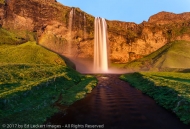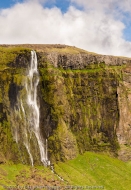


Sometimes the most interesting things are found on the way to something else. That’s how it is with the tufa towers at Mono Lake.
Last week I talked about wanting to hike to the top of Mount Dana to challenge myself a bit and get a photo of Mono Lake way down below in the Great Basin Desert. This was to be the pinnacle, as it were, of my late summer trip to the high meadows of Yosemite National Park. But what I didn’t mention was the treasures that awaited me down at Mono Lake itself.
Because I wasn’t much of a camper back in 2008, my lodging options on the east side of the park were mostly limited to the little town of Lee Vining, California. And Lee Vining sits right on the edge of Mono Lake. Well, big deal, right? You’ve seen one lake, you’ve seen them all, right? Wrong! Mono Lake is nothing like you’ve ever seen, and has the history and politics to match the scenery.
 Mono Lake is a 65 square mile ancient lake, over one million years old, and one of the oldest lakes in North America. So, no, it wasn’t created by building some ugly concrete dam and cutting down a bunch of trees, leaving tree stumps standing around the edges like so many “lakes” that are usually filled with speed boats.
Mono Lake is a 65 square mile ancient lake, over one million years old, and one of the oldest lakes in North America. So, no, it wasn’t created by building some ugly concrete dam and cutting down a bunch of trees, leaving tree stumps standing around the edges like so many “lakes” that are usually filled with speed boats.
No, Mono Lake didn’t need to be dammed because it never had an outlet. Ever! So think about what that means for a minute. What happens in Mono Lake stays in Mono Lake. Forever. All the salts and minerals that come down from the Sierra mountain streams flow into the lake, and the fresh water evaporates. But the minerals stay. So over time, the water becomes more and more salty and alkaline. And that affects what lives in these waters as well as what “grows” in these waters.
As for what lives in the lake, it’s a short list. Brine shrimp. That’s it. No fish can survive the super-salinated water, but the shrimp love it. Well, only an estimated 4-6 trillion of them during the summmer, that is. They feed on microscopic planktonic algae and themselves become food for birds.
As for what “grows” here, that’s the strange part. It seems that underwater springs rich in calcium bubble up into the carbonate rich water and form calcium carbonate, or limestone. While these towers are only created under water, they don’t necessarily stay there. And that’s where things get complicated.
 Back in 1941, the Los Angeles Department of Water and Power began diverting Mono Lake’s tributary streams 350 miles south to meet the water demands of L.A. And guess what happened to the lake? Well, the level dropped 45 feet and the salinity increased, obviously. In fact, the level dropped so much that the island that had existed in the middle became a peninsula, and predators marched right out and gobbled up the eggs of whatever was nesting out there. And the shrimp? They weren’t happy about the doubling of the salinity in the lake, so they moved on. In other words, the ecosystem collapsed.
Back in 1941, the Los Angeles Department of Water and Power began diverting Mono Lake’s tributary streams 350 miles south to meet the water demands of L.A. And guess what happened to the lake? Well, the level dropped 45 feet and the salinity increased, obviously. In fact, the level dropped so much that the island that had existed in the middle became a peninsula, and predators marched right out and gobbled up the eggs of whatever was nesting out there. And the shrimp? They weren’t happy about the doubling of the salinity in the lake, so they moved on. In other words, the ecosystem collapsed.
Eventually, environmental groups like the Mono Lake Committee had had enough of this, and pressured the city of L.A. to be a bit more responsible. But as it stands, the lake will never achieve historic levels, as water is still being diverted. Even if it did, parts of the ecosystem would not recover in our lifetimes. But the good news, if there is any, is that some of these fantastic tufa structures are and will remain visible for all to admire. And they are truly amazing to see.
 So what could be stranger than tufa towers that grow out of the water and look like bunny rabbits? How about alkali flies that move in unison along the shore in wavelike fashion? Just like swarms out of a Michael Crichton novel, these little guys will move out of the way as you approach – by the millions – and always in a neat, completely organized wave motion. I swear, you have not lived until you’ve seen these things in action. And don’t worry, unlike many types of flies, they don’t bite. They just perform!
So what could be stranger than tufa towers that grow out of the water and look like bunny rabbits? How about alkali flies that move in unison along the shore in wavelike fashion? Just like swarms out of a Michael Crichton novel, these little guys will move out of the way as you approach – by the millions – and always in a neat, completely organized wave motion. I swear, you have not lived until you’ve seen these things in action. And don’t worry, unlike many types of flies, they don’t bite. They just perform!
So if you ever find yourself in the Yosemite high country of Tuolumne Meadows, or along CA 395 between Carson City and Bishop, take the time to check out Mono Lake, and South Tufa in particular. You’ll see some sights that truly belong to another world.

How interesting, Ed! And beautiful pictures. I would love to go there. Thank you.
Fascinating. I love the colors!